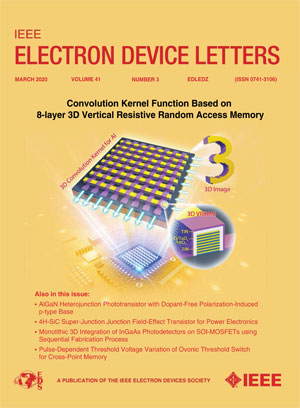Electrohydrodynamic Printing Enables Ultrahigh Resolution Quantum Dot Light-Emitting Diodes
IF 4.5
2区 工程技术
Q2 ENGINEERING, ELECTRICAL & ELECTRONIC
引用次数: 0
Abstract
Electrohydrodynamic (EHD) printing is a promising method for manufacturing high-resolution quantum dot light-emitting diodes (QLEDs). The stability of the EHD printing process and the morphology of final quantum dot (QD) film are highly dependent on the ink formulation. To solve this problem, we selected a ternary solvent (decahydronaphthalene, tetradecane and nonane) ink for cadmium-based QDs (CdSe/ZnS) to achieve excellent QD dispersion while eliminating the “coffee ring” effect, resulting in high quality QD films. We also fabricated a complete QLED device by printing a light-emitting layer formed by linearly aligned strips of QDs, achieving an external quantum efficiency (EQE) of 19.2 %, which is one of the highest levels of printing devices. On this basis, we introduced patterned PMMA structures prepared by nanoimprinting method to achieve ultrahigh resolu-tion devices. The pixel density achieved was 8,758 pixels per inch (PPI), with a maximum EQE of 10.5 %. The luminance is 9530.43 cd/m2 at a voltage of 4 volts. This work shows promising potential in realizing ultra-high resolution and high-performance QLEDs.电流体动力打印实现超高分辨率量子点发光二极管
电流体动力(EHD)印刷是制造高分辨率量子点发光二极管(qled)的一种很有前途的方法。EHD打印过程的稳定性和最终量子点(QD)薄膜的形态高度依赖于油墨配方。为了解决这一问题,我们选择了一种三元溶剂(十氢萘、十四烷和壬烷)用于镉基量子点(CdSe/ZnS)的油墨,在消除“咖啡环”效应的同时,实现了优异的量子点分散性,从而获得了高质量的量子点薄膜。我们还通过打印由线性排列的量子点条带形成的发光层,制作了一个完整的QLED器件,实现了19.2%的外部量子效率(EQE),这是印刷器件的最高水平之一。在此基础上,我们介绍了采用纳米印迹方法制备的PMMA结构,以实现超高分辨率器件。实现的像素密度为每英寸8,758像素(PPI),最大EQE为10.5%。在4伏电压下,亮度为9530.43 cd/m2。这项工作在实现超高分辨率和高性能qled方面显示出很大的潜力。
本文章由计算机程序翻译,如有差异,请以英文原文为准。
求助全文
约1分钟内获得全文
求助全文
来源期刊

IEEE Electron Device Letters
工程技术-工程:电子与电气
CiteScore
8.20
自引率
10.20%
发文量
551
审稿时长
1.4 months
期刊介绍:
IEEE Electron Device Letters publishes original and significant contributions relating to the theory, modeling, design, performance and reliability of electron and ion integrated circuit devices and interconnects, involving insulators, metals, organic materials, micro-plasmas, semiconductors, quantum-effect structures, vacuum devices, and emerging materials with applications in bioelectronics, biomedical electronics, computation, communications, displays, microelectromechanics, imaging, micro-actuators, nanoelectronics, optoelectronics, photovoltaics, power ICs and micro-sensors.
 求助内容:
求助内容: 应助结果提醒方式:
应助结果提醒方式:


